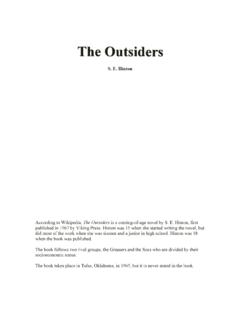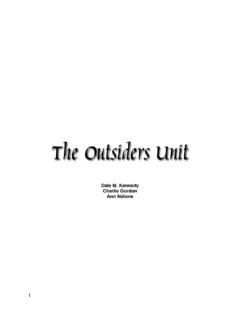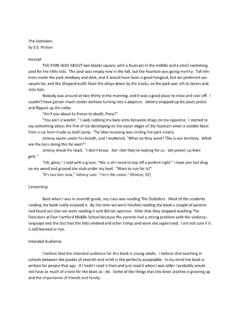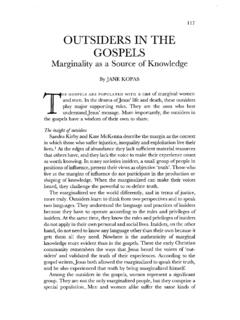Transcription of Outsiders—Defining Deviance - Lee Clarke
1 outsiders DefiningDevianceHOWARDBECKERIn this article, Howard Becker defines outsiders as individuals who breaka rule agreed on by a group. Becker also claims that rule breakers mayperceive a person who enforces the rule as an outsider. In other words,Becker argues, many different facets of deviant behavior are relative. This1963 piece established an early foundation for what has become known asthe interactionist theory of deviant social groups make rules and attempt, at some times and undersome circumstances, to enforce them. Social rules define situationand the kinds of behavior appropriate to them, specifying some actions as right and forbidding others as wrong.
2 When a rule is enforced, theperson who is supposed to have broken it may be seen as a special kind ofperson, one who cannot be trusted to live by the rules agreed on by thegroup. He is regarded as an outsider. But the person who is thus labeled an outsider may have a differentview of the matter. He may not accept the rule by which he is being judgedand may not regard those who judge him as either competent or legitimatelyentitled to do so. Hence, a second meaning of the term emerges: the rule-breaker may feel his judges are outsiders . In what follows, I will try to clarify the situation and process pointed toby this double-barrelled term: the situations of rule-breaking and rule-enforcement and the processes by which some people come to break rulesand others to enforce them.
3 Some preliminary distinctions are in order. Rules may be of a greatmany kinds. They may be formally enacted into law, and in this case thepolice power of the state may be used in enforcing them. In other cases, theyrepresent informal agreements, newly arrived at or encrusted with the sanc- The outsiders , by Howard Becker, reprinted from The outsiders : Studies in the Sociology ofDeviance, 1963, pp. 1 18. Copyright 1963 by the Free of age and tradition; rules of this kind are enforced by informal sanc-tions of various kinds. Similarly, whether a rule has the force of law or tradition or is simplythe result of consensus, it may be the task of some specialized body, such asthe police or the committee on ethics of a professional association, to enforceit; enforcement, on the other hand, may be everyone s job or, at least, thejob of everyone in the group to which the rule is meant to apply.
4 Many rules are not enforced and are not, in any except the most formalsense, the kind of rules with which I am concerned. Blue laws, which remainon the statute books though they have not been enforced for a hundredyears, are examples. (It is important to remember, however, that an unen-forced law may be reactivated for various reasons and regain all its originalforce; as recently occurred with respect to the laws governing the opening ofcommercial establishments on Sunday in Missouri.) Informal rules maysimilarly die from lack of enforcement. I shall mainly be concerned withwhat we can call the actual operating rules of groups, those kept alivethrough attempts at enforcement.
5 Finally, just how far outside one is, in either of the senses I havementioned, varies from case to case. We think of the person who commits atraffic violation or gets a little too drunk at a party as being, after all, not verydifferent from the rest of us and treat his infraction tolerantly. We regard thethief as less like us and punish him severely. Crimes such as murder, rape,or treason lead us to view the violator as a true outsider. In the same way, some rule-breakers do not think they have beenunjustly judged. The traffic violator usually subscribes to the very rules hehas broken. Alcoholics are often ambivalent, sometimes feeling that thosewho judge them do not understand them and at other times agreeing thatcompulsive drinking is a bad thing.
6 At the extreme, some deviants (homo-sexuals and drug addicts are good examples) develop full-blown ideologiesexplaining why they are right and why those who disapprove of and punishthem are wrong. Definitions of DevianceThe outsider the deviant from group rules has been the subject of muchspeculation, theorizing, and scientific study. What laymen want to knowabout deviants is: why do they do it? How can we account for their rule-breaking? What is there about them that leads them to do forbidden things? outsiders DEFININGDEVIANCE Scientific research has tried to find answers to these questions. In doing soit has accepted the common-sense premise that there is something inher-ently deviant (qualitatively distinct) about acts that break (or seem to break)social rules.
7 It has also accepted the common-sense assumption that thedeviant act occurs because some characteristic of the person who commits itmakes it necessary or inevitable that he should. Scientists do not ordinarilyquestion the label deviant when it is applied to particular acts or peoplebut rather take it as given. In so doing, they accept the values of the groupmaking the judgment. It is easily observable that different groups judge different things to bedeviant. This should alert us to the possibility that the person making thejudgment of Deviance , the process by which that judgment is arrived at, andthe situation in which it is made may all be intimately involved in thephenomenon of Deviance .
8 To the degree that the common-sense view ofdeviance and the scientific theories that begin with its premises assume thatacts that break rules are inherently deviant and thus take for granted thesituations and processes of judgment, they may leave out an important vari-able. If scientists ignore the variable character of the process of judgment,they may by that omission limit the kinds of theories that can be developedand the kind of understanding that can be first problem, then, is to construct a definition of Deviance . Beforedoing this, let us consider some of the definitions scientists now use, seeingwhat is left out if we take them as a point of departure for the study ofoutsiders.
9 The simplest view of Deviance is essentially statistical, defining asdeviant anything that varies too widely from the average. When a statisticiananalyzes the results of an agricultural experiment, he describes the stalk ofcorn that is exceptionally tall and the stalk that is exceptionally short as devi-ations from the mean or average. Similarly, one can describe anything thatdiffers from what is most common as a deviation. In this view, to be left-handed or redheaded is deviant, because most people are right-handed andbrunette. So stated, the statistical view seems simple-minded, even trivial. Yet itsimplifies the problem by doing away with many questions of value thatordinarily arise in discussions of the nature of Deviance .
10 In assessing anyparticular case, all one need do is calculate the distance of the behaviorinvolved from the average. But it is too simple a solution. Hunting with sucha definition, we return with a mixed bag people who are excessively fat or outsiders DEFININGDEVIANCE thin, murderers, redheads, homosexuals, and traffic violators. The mixturecontains some ordinarily thought of as deviants and others who have brokenno rule at all. The statistical definition of Deviance , in short, is too farremoved from the concern with rule-breaking which prompts scientificstudy of outsiders . A less simple but much more common view of Deviance identifies it assomething essentially pathological, revealing the presence of a disease.









